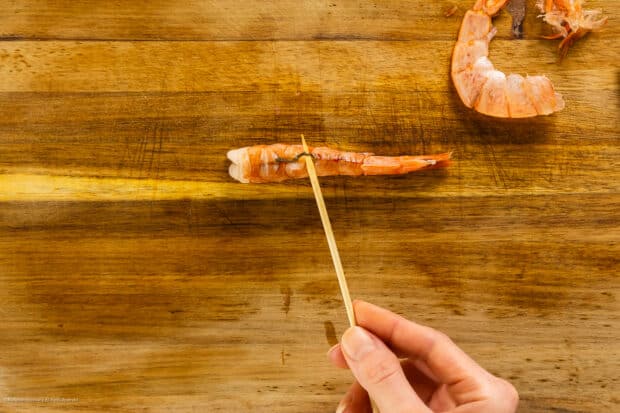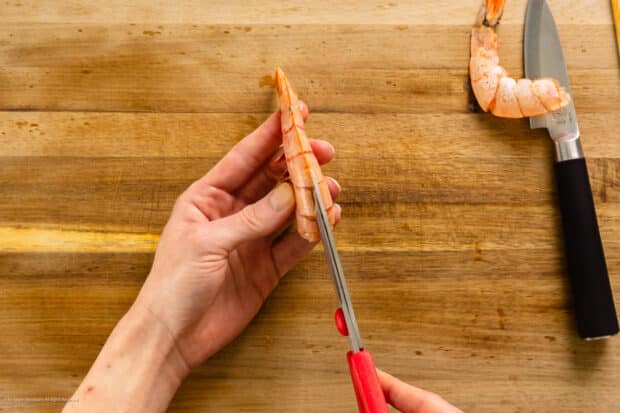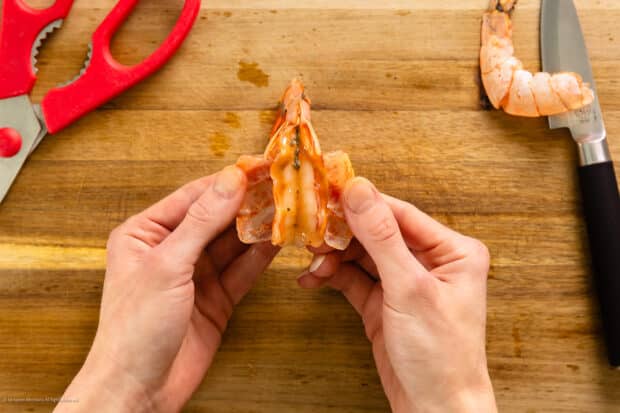Tutorial for Peeling and Deveining Shrimp

Stop overpaying for peeled and deveined crustaceans at the grocery store and learn how to clean shrimp yourself. This easy step-by-step tutorial walks you through the quickest methods of how to peel raw shrimp and the easiest way to devein shrimp at home.
Equipment
- 1 Sheet Pan or Baking Pan (filled with ice)
- 1 Cutting Board
- 1 Paring knife or Kitchen Shears
- 1 Colander
Ingredients
- 1 Pound Thawed Shrimp (substitute: Prawns)
Instructions
- Prep and Gather: Grab a large, rimmed sheet pan or a large baking pan and fill it with ice cubes. Collect the shrimp from the refrigerator and arrange them on the ice. (Why? You need to keep your shrimp cold to avoid food-borne illness.)

- Remove Head, if applicable: Working with one shrimp at a time over a clean cutting board, hold the shrimp in your hand and twist off the head if it’s still attached. Alternatively, you can simply chop off the head if you prefer.
Peeling with a paring knife
- Peel Shrimp and Remove Shells - paring knife method: Use your fingers to pull off and remove the legs from the underside of the shrimp. Then, starting from the head and working from the bottom (underside of the shrimp), slide your thumb up and under the edge of the shell and pull the shell off in one piece. Leave the tail attached for “shrimp hand-held” recipes, like Ebi tempura and shrimp cocktail. For all other recipes, you can gently pinch the tail to pull it right off the shrimp. Once you have peeled the shrimp, place it back on the tray of ice and repeat peeling all the remaining shrimp.

- Devein the Shrimp with Paring Knife: Hold the shrimp in your hand so the back of the shrimp is facing you. Now, locate the black vein running along the back of the shrimp or prawn. Next, work from the head of the shrimp and go down about ½ to 1-inch along the back. Then, use a sharp paring knife to carefully make a small incision along the back to reveal the vein. Next, you are going to want to insert the tip of a wooden skewer or toothpick underneath the vein, perpendicular to it. To do this, insert the skewer sideways, underneath the vein and gently pull up on the skewer tip to lift the vein up towards you and off the shrimp. Then, pull on the vein using your fingers or the skewer to completely remove and discard it from the shrimp. Once the shrimp is deveined, place it back onto the tray of ice and repeat deveining the remaining shrimp. (Tip 1: Sometimes shrimp have larger, fuller intestinal tracks or very thin, delicate tracks that are more difficult to remove. Simply use your paring knife and butterfly the back of the shrimp to fully expose the intestinal track.) (Tip 2: Keep paper towels nearby to wipe your hands as the black veins can be sticky!) (Tip 3: The vein is slightly elastic; however, it will break. Simply use your fingers to pull both sides out when breaks happen.)

Peeling with a pair of kitchen shears
- Peel Shrimp and Remove Shells – kitchen scissors method: Hold the shrimp in your hand so its back is facing you. Next, insert the tip of the kitchen shears between the shrimp meat and the shrimp shell, and begin to cut into the shell along the back of the shrimp. Stop snipping when you get to the tail. Use your fingers to carefully peel back the shell on either or both sides of the shrimp and discard. Leave the tail attached for “shrimp hand-held” recipes, like Ebi tempura and shrimp cocktail. For all other recipes, you can gently pinch the tail to pull it right off the shrimp. Once you have peeled the shrimp, place it back on the tray of ice and repeat peeling all the remaining shrimp.

- Devein the Shrimp – kitchen scissors method: Since you used kitchen shears, your shrimp should be scored open (butterflied) along the back. If it’s not, use your paring knife to gently make a shallow cut along the back of the shrimp to expose the black vein. Use your paring knife to gently pull up on the vein, lifting it towards you and off the shrimp, discarding the vein. (Tip 1: Keep paper towels nearby to wipe your hands as the black veins can be sticky!) (Tip 2: When lifting and removing the vein, start at the top, or the head, and work towards the bottom.)

- Wipe or Rinse Shrimps: Clean the shrimp using your preferred method:Paper Towels: Use clean paper towel to gently wipe the shrimp to remove any excess grit or errant veins.Colander + Water: Transfer the peeled and deveined shrimp to a colander and gently rinse with cool water to remove any grit. Drain and pat the shrimp THOROUGHLY dry before using.

- Use Cleaned Shrimp: Use peeled, deveined shrimp to make your favorite recipes.(Tip: Moisture is the enemy of shrimp – make sure you pat them as thoroughly dry as possible before using.)

- Store for Later: Store your shrimp using one of the methods below:Very short-term storage: Place the peeled, deveined shrimp back onto a tray or bowl of ice and refrigerate until ready to use.Storage: Transfer the shrimp to a resealable storage bag, press out all the air, and seal. Store shrimp in the fridge for up to 48 hours.

Notes
- Shrimp: If your shrimp are frozen, make sure you thaw them prior to peeling and deveining.
- Peeling and Deveining Process: Be gentle when during this process, as you don’t want to tear the shrimp meat.
- Save the shrimp shells to make seafood stocks or poaching liquids.
Nutrition
Calories: 96kcal Protein: 23g Fat: 1g Saturated Fat: 0.1g Polyunsaturated Fat: 0.2g Monounsaturated Fat: 0.1g Trans Fat: 0.01g Cholesterol: 183mg Sodium: 135mg Potassium: 299mg Calcium: 73mg Iron: 1mg